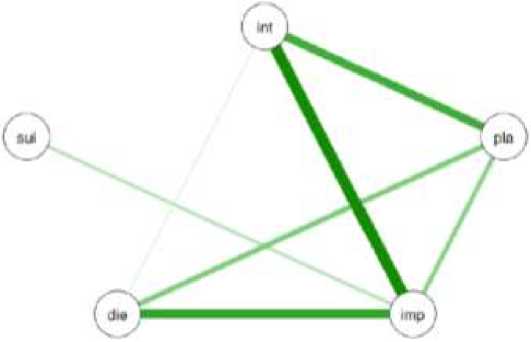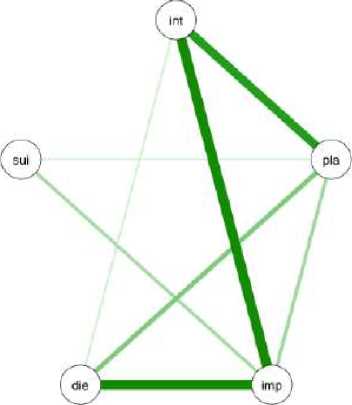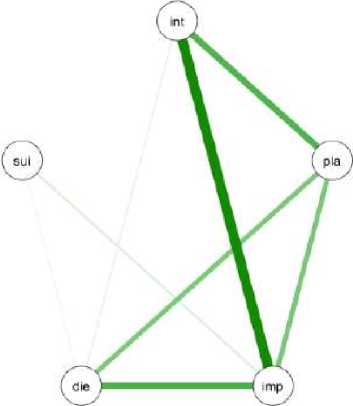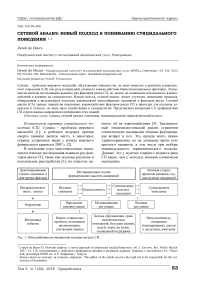Сетевой анализ: новый подход к пониманию суицидального поведения
Бесплатный доступ
Суицид - проблема мирового масштаба, обсуждаемая повсеместно, но мало известно о развитии суицидального поведения (СП) как результирующей сложного взаимодействия биопсихосоциальных факторов. Эпидемиологические исследования выявили ряд факторов риска СП, но далеко до понимания механизма их взаимодействий и влияния на суицидогенез. Новый подход, сетевой анализ, может улучшить понимание процесса, обнаруживая и визуализируя комплекс взаимосвязей многообразных признаков и факторов риска. Сетевой анализ (СА) данных пациентов показывает взаимодействие факторов риска СП и пригоден для изучения депрессии и психоза, но пока мало задействован в суицидологии. Представлена концепция СА профилактики СП и предложены направления применения этих знаний.
Суицид, сетевой анализ, симптомы, индивидуальный терапевтический подход
Короткий адрес: https://sciup.org/140225875
IDR: 140225875 | УДК: 616.89-008
Текст научной статьи Сетевой анализ: новый подход к пониманию суицидального поведения
Комплексный характер суицидального поведения (СП). Суицид – проблема мирового масштаба [1]: в рейтинге ведущих причин смерти занимая десятое место, в некоторых странах устремился вверх с начала мирового финансового кризиса в 2007 г. [2].
В последние годы многочисленные эпидемиологические исследования выявили ряд факторов риска СП, такие как половые различия и психические расстройства [3], но известно не- много об их взаимодействии [4]. Традиционный эпидемиологический анализ ограничен статистически значимыми общими факторами, как возраст и пол. Это, прежде всего, важно здравоохранению, но не лечащему врачу конкретного пациента, в том числе при выборе индивидуального терапевтического подхода. Данные, что у мужчин старшего возраста риск СП выше, чем у молодых женщин клинически малоценны.
Домотивационная стадия: основные и триггерные факторы
Мотивационная стадия: формирование мыслей, намерений
Волевая стадия: принятие решения, осуществление намерений
Предрасположенность / диатез
+
Неудачи, унижение
→
→
→
Безысходность
→
→
→
↑ ↑
Окружение
Нарушение саморегуляции
+
Жизненные события
↑
Боязнь социальных проблем, негативные воспоминания, умственная жвачка
Суицидальные мысли и тенденции
Мотивационная регуляция
→
→
→
↑
Суицидальное поведение
Волевая регуляция
↑
Боязнь обременения, срыв межличностных отношений, будущих планов, целей, норм, взглядов, социальной поддержки
↑
Импульсивность, намерения (планирование), доступ к средствам, имитация
Рис. 1. Объединённая мотивационно-волевая модель СП.
В последнее время модели СП сосредоточены вокруг основополагающей биопсихосо-циальной парадигмы [4]. Для облегчения комплексного анализа СП разработана объединённая мотивационно-волевая модель (Integrated Motivational Volitional Model, или ОМВМ) (рис. 1) [4, 5].
ОМВМ подразумевает, что СП в развитии проходит мотивационные и волевые фазы. Первая описывает симптомы, которые связаны с появлением суицидальных мыслей. Признаками стадии служат ощущение безысходности, совладание, навязчивые мысли. Волевая стадия – диапазон от суицидальных мыслей, представлений до суицидальных тенденций – связана с большим риском СП. Выделены центральные аспекты модели [4]: безысходность и безнадёжность [6]. По ОМВМ, волевые факторы определяют границу между совершившими суицидальную попытку и лишь помышляющими о суициде [7]. Следующий логический шаг – обнаружение связи между сосуществующими в комплексной модели факторами. Для понимания взаимодействия между многими переменными предложен сетевой анализ (СА).
СА в психопатологии. Психопатологические симптомы, как усталость, бессилие и сниженное настроение взаимодействуют и влияют друг на друга [8]. Этот подход отличается от подхода классической медицины, используемого в соматической практике, согласно которому, к примеру, головная боль – проявление возможной опухоли. Так и в основе симптомов, как сниженное настроение, апатия, суицидальные мысли обычно психическое расстройство, как депрессивное (ДР).
Так и опухоль не обязательно проявляется головной болью, а головная боль не всегда подразумевает опухоль, то есть необходимо отделять медицинское условие (субстрат, диагноз) от симптомов [8]. Эта точка зрения не находит эмпирического применения в психопатологии: вряд ли ДР не сопровождает печаль [8]. Подход СА к психопатологии признан, так как предлагает альтернативное объяснение сосуществования психопатологических симптомов [9]. В последние годы интенсивно развиваются статистические модели и программное обеспечение СА депрессии, психоза и ПТСР [9]. Хотя суицидальные мысли и СП не принято полагать нозологической категорией (оспорено [10]), СА может объяснить сложные модели СП, выявить различия подгрупп суицидентов и персонифицировать помощь и терапию.
Применение СА в профилактике СП.
Комплексные модели СП. ОМВМ (рис. 1) выделяет составляющие домотивационной, мотивационной (переживания и формирование намерений) и волевой (принятие решения, осуществление намерения) стадий СП. По ОМВМ, суицидальные мысли появляются при взаимодействии переживаний неудачи и безысходности и дополнительных симптомов: навязчивые размышления, низкий уровень социальной поддержки [5]. Такие черты характера, как импульсивность и затруднения планирования могут быть триггерами перехода от мотивационной к волевой стадии. Взаимодействие между элементами модели может быть проанализировано как сеть. Так, в определённый момент (поперечный срез) суицидентов просили оценить пять утверждений по пятибалльной шкале. Выше балл – больше степень согласия. Из пяти положений два характеризовали мотивационную стадию (неотступные мысли о смерти, суициде), три – волевую стадию (я склонен к импульсивным поступкам, есть план суицида, жду подходящего момента). Отношения между ответами респондентов могут быть проанализированы при помощи корреляционной матрицы 5 х 5. Бесплатный программный пакет [11] позволяет визуализировать матрицу корреляций как сеть, в которой каждый узел обозначает некое положение, явление, а линия – корреляцию между ними. В сети два узла связаны линией, если между ними достоверная связь. Последняя может быть обнаружена и показана матрицей частичной корреляции. Она используется чаще при изучении ложных связей и зависимости в некой условной структуре.

Рис. 2. Гипотетический пример СА суицидальных симптомов. (Int – интенсивность суицидальных мыслей; pla – конкретный план; imp – импульсивность, die – желание умереть; sui – готовность к суициду. Линии зелёного цвета обозначают положительные связи. Чем толще линия – сильнее зависимость.)
Не связанные узлы независимы от иных переменных. Больше информации по основам статистики и методологии в дополнительных источниках [11-15]. Вариант СА пяти вышеуказанных пунктов на рис. 2.
Рис. 2 показывает отношения между признаками ОМВМ как сети. В гипотетической сети четыре признака (интенсивность суицидальных мыслей (int), планирование (pla), импульсивность (imp), желание умереть (die) связаны с разной силой. Далее, согласно модели, только импульсивность непосредственно связана с вероятностью попытки суицида. Рассматривая эту сеть более абстрагировано, можно проследить развитие суицидального процесса, вычленить центральные, важные признаки и их связь с другими факторами [9]. У основных узлов предположительно наибольшее количество связей, и какие-либо изменения с их стороны вероятнее вызовут цепную реакцию в сети по принципу обратной связи. Раннее выявление и лечение могут сосредотачиваться на этих признаках, что, скорее всего, повлияет и на другие симптомы. Итак, получим возможность определять показатели суицидального кризиса.
Различия пациентов. СП отличается в подгруппах пациентов. Так, СП имеет половые различия [3, 16]. Индивидуальный анализ симптомов СП в длительных исследованиях показал, что стресс увеличивал риск СП только в подгруппах мужчин [17]. Многие исследователи не учитывают различия подгрупп [7, 18, 19], что ведёт к выявлению неспецифических факторов риска, имеющих ограниченное значение в предупреждении СП. Понимание раз- личий структуры симптомов в подгруппах поможет уточнению диагностики. При создании модели СА учитывает различия в подгруппах пациентов. Так, на рис. 3 смоделированы сети для мужчин и женщин, и показаны тонкие половые различия в структуре сети. В подгруппе мужчин импульсивность теснее связана с готовностью к суициду, СП и планирование взаимосвязаны, тогда как в подгруппе женщин подобная связь, вероятно, отсутствует.
Программное обеспечение R package Network Comparison Test (NCT) позволяет формально проверить различие между сетями [20, 21]. Неэмпирический пример даёт ключ к пониманию потенциала СА в выявлении различий подгрупп пациентов. Выявленные особенности могут быть переведены в большее количество калиброванных диагностических критериев диагностики СП.
Индивидуальный терапевтический подход с использованием СА данных пациента. Когда данные собираются в течение определённого времени, через конкретные временные отрезки, например, при помощи телефона [22], можно сформировать уникальную индивидуальную сеть для отдельного пациента. То есть сеть будет сформирована не на уровне группы пациентов, а представлена персональной статистической моделью.
При помощи такой уникальной аналитической модели пациент может научиться пониманию взаимодействия психопатологических симптомов, раннему распознаванию суицидального кризиса.
Мужчины

Рис. 3. Гипотетическая сеть симптомов СП мужчин и женщин (Males – мужчины, Females – женщины, Int – интенсивность суицидальных мыслей; pla – конкретный план; imp – импульсивность, die – желание умереть; sui – готовность к суициду. Зеленые линии обозначают положительные связи. Чем толще линия – сильнее зависимость.)
Женщины

Пациент может использовать личную сеть как инструмент улучшения и индивидуализации лечения. В необычном исследовании единственная участница год контролировала психотические симптомы, оценивая 10 параметров самочувствия четырежды в неделю [23]. Сетевые данные позволили повысить степень понимания соотношения симптомов и динамики общего состояния при изменении конкретных показателей, что помогало пациентке предвидеть рецидив, улучшая самоконтроль и реабилитацию. В идеальных условиях такая сеть должна создаваться при участии профессионалов и близких пациента, то есть три участника формируют сеть, обсуждая и планируя терапию. Подобная программа исследования СП с использованием мобильного телефона начата Свободным университетом Амстердама. Непрерывная оценка профилактики СП (Continuous Assessment for Suicide Prevention and Research, CASPAR) подразумевает сбор данных в группе (n=30-60) получающих специализированную медицинскую помощь. Эти данные в конце 2017 г. станут первым инструментом индивидуальных аналитических моделей СП.
Обсуждение. СА может улучшить понимание механизмов СП, различение подгрупп пациентов. Сетевые исследования в других областях психиатрии обнаружили ряд новых данных: более густая, насыщенная сеть связана с дальнейшей депрессией [20]; показана взаимосвязь детской психотравмы и психотических симптомов [24]. Для суицидента важна информация о своём состоянии при помощи уникальной персонифицированной сети, что делает лечение более индивидуальным и безопасным. СП – диагностически сложная структура, и СА может стать хорошим подспорьем клиницистам и их пациентам.
Социальные сети и СП. В социологии взгляд на СП с позиции сети представлен в 1989 г. [25]. Авторы пересмотрели теорию Э. Дюркгейма об антисуицидальной роли религии, уточнив, что сила религии зависит от силы влияния социальной группы, в которой она распространена. Модель СП представлена взаимодействием социальных факторов, а не комплексом связей между симптомами [26]. Работы Э. Дюркгейма и современных социологов актуальны и весомы в суицидологии как историческое наследие и основа научных традиций [26], но разительно отличны от подхода данной статьи.
Дальнейшие исследования. Для применения СА необходимы два условия: большая выборка с основными суицидальными симптомами и программное обеспечение R (R Foundation, Вена, Австрия). Разработчик предлагает упрощённую версию с более удобным пользовательским интерфейсом, учебные пособия [11]. Сайты (psychosystems.org) предлагают виртуальное обсуждение СА научным сообществом. Международной группой суицидологов планируется пересмотреть национальные и международные выборки данных суицидентов с использованием СА в рамках проекта SUPER (Suicide Prevention by Extending Research). Длительное нидерландское исследование NESDA – база данных о симптомах депрессии, тревоги, СП более 3000 пациентов [27]. Шотландское исследование благополучия (Scottish Wellbeing Study) содержит данные о безысходности, неудачах, социальной изоляция, навязчивых воспоминаниях и образах, боязни обременения 3500 подростков. Бельгийская база самоповреждений включает данные > 15000 суицидентов, лечившихся в клиниках за 26 лет [28]. С помощью нового подхода возможна коррекция взглядов на половые различия СП, взаимодействие суицидальных симптомов. Планируется более детальное изучение депрессии в группах пациентов с СП и без оного.
Итак, необходимым условием качественного анализа служит большая выборка: количество наблюдений соответствует количеству заданных параметров. Для исследования 10 симптомов – взять ≥ 55 случаев (10 параметров + 10 х 9/2 возможных взаимодействий), для 20 и 50 пунктов – 210 и 1250 соответственно [15]. Общие базы данных населения, как правило, указывают заниженные показатели психопатологической симптоматики в связи с относительно малой долей «больных». При выявлении подгрупп респондентов с высокими показателями психопатологической симптоматики рекомендовано сравнение с общей выборкой [29]. При построении сети с использованием поперечных данных прямая причинная связь не прослеживается [9]. Доказательства, что воздействие на некие ключевые симптомы приводит к уменьшению психопатологической симптоматики следует искать в длительных исследованиях. Объединение СА с латентным [14] как моделирование структурными уравнениями может дополнить информацию. Появляются другие инновации в статистике. Например, посредством алгоритма компьютерного исследования клинических данных обнаружены показатели особого ответа пациентов на определенные антидепрессанты [30]. Теория СА и его программное обеспечение совершенствуются. Следить за обновлениями можно на сайте
Выводы: Применение СА в суицидологии может улучшить понимание механизмов СП при обнаружении связей между большим количеством симптомов и факторов риска.
Список литературы Сетевой анализ: новый подход к пониманию суицидального поведения
- WHO. World Health Organization Public Health Action for the Prevention of Suicide. Available online: http://www.who.int/rn. 2012.
- Oyesanya M., Lopez-Morinigo J., Dutta R. Systematic review of suicide in economic recession. World J. Psychiatry. 2015; 5: 243-54.
- Hawton K., van Heeringen K. Suicide. Lancet. 2009; 373: 1372-81.
- O’Connor R.C., Nock M.K. The psychology of suicidal behavior. Lancet Psychiatry. 2014; 1: 73-85.
- O’connor R.C. Towards an Integrated Motivational-Volitional Model of Suicidal Behaviour. In International Handbook of Suicide Prevention: Research, Policy and Practice. -USA, NJ, Wiley-Blackwell: Hoboken. 2011: 181-98.
- O’Connor R.C., Smyth R., Williams J.M.G. Intrapersonal positive future thinking predicts repeat suicide attempts in hospital-treated suicide attempters. J. Consult. Clin. Psychol. 2015; 83: 169-76.
- O’Connor R.C., Rasmussen S., Hawton K. Distinguishing adolescents who think about self-harm from those who engage in self-harm. Br. J. Psychiatry. 2012; 200: 330-5.
- Borsboom D., Cramer A.O.J. Network Analysis: An Integrative Approach to the Structure of Psychopathology. Ann. Rev. Clin. Psychol. 2013; 9: 91-121.
- Fried E.I., van Borkulo C.D., Cramer A.O.J. et al. Mental disorders as networks of problems: A review of recent insights. Soc. Psychiatry Psychiatr. Epidem. 2016; 58: 7250-7.
- Oquendo M.A., Baca-Garcia E. Suicidal behavior disorder as a diagnostic entity in the DSM-5 classification system: Advantages outweigh limitations. World Psychiatry. 2014; 13: 128-30.
- Epskamp S., Cramer A.O.J., Waldrop L.J. et al. Network visualizations of relationships in psychometric data. J. Stat. Soft. 2012; 48: 1-18.
- Costantini G., Epskamp S., Borsboom D. et al. State of the aRt personality research: A tutorial on network analysis of personality data. R. J. Res. Personal. 2015; 54: 13-29.
- Van Borkulo C.D., Borsboom D., Epskamp S. et al. A new method for constructing networks from binary data. Sci. Rep. 2014; 4: 5918.
- Epskamp S., Rhemtulla M., Borsboom D. Generalized Network Psychometrics: Combining Network and Latent Variable Models. arXiv:1605.09288.
- Epskamp S., Borsboom D., Fried E.I. Estimating Psychological Networks and their Stability: A Tutorial Paper. arXiv: 1604.08462.
- De Beurs D.P., Hooiveld M., Kerkhof A.J. et al. Trends in suicidal behaviour in Dutch general practice 1983-2013: A retrospective observational study. BMJ Open. 2016; 6: e010868.
- Fried E.I., Nesse R.M., Zivin K. et al. Depression is more than the sum score of its parts: Individual DSM symptoms have different risk factors. Psychol. Med. 2013; 44: 2067-76.
- De Beurs D.P., de Groot M.H., de Keijser J. et al. Evaluation of benefit to patients of training mental health professionals in suicide guidelines: Cluster randomised trial. Br. J. Psychiatry. 2015; 208: 477-83.
- Dhingra K., Boduszek D., O’Connor R.C. A structural test of the Integrated Motivational-Volitional model of suicidal behavior. Psychiatry Res. 2016; 239: 169-78.
- Van Borkulo C., Boschloo L., Borsboom D. et al. Association of Symptom Network Structure with the Course of Longitudinal Depression. JAMA Psychiatry. 2015; 72: 1219-26.
- Rpackage Network Comparison Test. Available online: https://cran.r-project.org/web/packages/
- De Beurs D., Kirtley O., Kerkhof A. et al. The role of mobile phone technology in understanding and preventing suicidal behavior. Crisis J. Crisis Interv. Suicide Prev. 2015; 36: 79-82.
- Bak M., Drukker M., Hasmi L. et al. An n=1 Clinical network analysis of symptoms and treatment in psychosis. PLoS ONE. 2016; 11: e0162811.
- Isvoranu A.M., van Borkulo C.D., Boyette L.L. et al. Network Approach to Psychosis: Pathways between Childhood Trauma and Psychotic Symptoms. Schizophr. Bull. 2016; 43: 187-96.
- Pescosolido B.A., Georgianna S. Durkheim, Suicide, and Religion: Toward a Network Theory of Suicide. Am. Sociol. Rev. 1989; 54: 33-48.
- Stack S. Suicide: A 15 Year Review of the Sociological Literature: Part II: Modernization and Social Integration Perspectives. Suicide Life Threat. Behav. 2000; 30: 163-76.
- Penninx B.W.J.H., Beekman A.T.F. et al. The Netherlands Study of Depression and Anxiety (NESDA): Rationale, objectives and methods. Int. J. Methods Psychiatr. Res. 2008; 17: 121-40.
- Vancayseele N., Portzky G., Van Heeringen K. Increase in selfinjury as a method of self-harm in Ghent, Belgium: 1987-2013. PLoS ONE. 2016; 11: e0156711.
- Terluin B., De Boer M.R., De Vet H.C.W. Differences in connection strength between mental symptoms might be explained by differences in variance: Reanalysis of network data did not confirm staging. PLoS ONE. 2016; 11: e0155205.
- Chekroud A.M., Zotti R.J., Shehzad Z. et al. Cross-trial prediction of treatment outcome in depression: A machine learning approach. Lancet Psychiatry. 2016; 3: 243-50.


